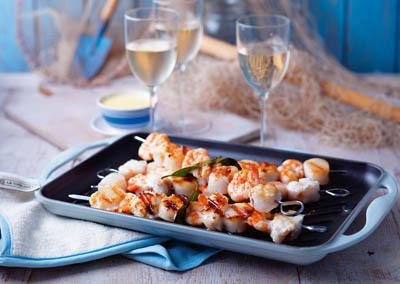Seafood Brochettes with White Wine Hollandaise
Simply grilled seafood with an extravagant buttery sauce is a perfect combination. Hollandaise may be a little more challenging for the novice cook but well worth the effort.
SERVES 4
Preparation time: 20-25 minutes
Cooking time: 25-30 minutes
INGREDIENTS
Seafood brochettes
- 300g (10oz) monkfish cut into 12 cubes
- 12 (150g /5 ½ oz) raw large tiger prawns
- 12 (200g/7oz) small sea scallops without roe
- 4 bay leaves
- 4 x 28cm (11inch) skewers
Marinade
- 2 tablespoons light olive oil
- 1 tablespoon lemon juice
- ¼ teaspoon salt
- ½ teaspoon black pepper
- A little vegetables oil to grease the grill
White wine hollandaise
- 125ml (½ cup) dry white wine
- 1 bay leaf
- 1 teaspoon peppercorns
- 3 egg yolks
- 175g (1 ½ sticks) butter
- 100ml (½ cup) fish stock reduced to 50ml (¼ cup)
Or 50ml (¼ cup) double strength fish stock from a cube - Freshly squeezed lemon juice
- Salt and pepper
METHOD
To make the brochettes
- Thread the seafood onto the skewers in equal proportions adding one bay leaf per brochette.
- Mix together the olive oil, lemon juice and seasoning in a small bowl and brush onto the brochettes. Cover and leave to marinate in a cool place for 1 hour.
Hollandaise preparation
- Place the white wine, bay leaf and peppercorns into a small pan and reduce to about 2 tablespoons. Strain the liquid into a small bowl and reserve. Clean the pan.
- Fill a medium saucepan to about a ¼ full with water, set on the on the hob over a medium heat and bring to a gentle simmer. Place on a lid until required.
- Heat the butter in the clean small pan until just melted. Set to one side.
To cook the brochettes
- Place the empty grill over a medium heat on the hob and allow it to heat for several minutes. Do not add oil to the cold pan before heating. Test the grill temperature by dropping a few drops of cold water over the hot surface. If it sizzles and the water evaporates almost immediately, it is hot and ready for use. If the water produces steam and has no sizzle, heat the pan for a little longer and repeat the test again. Use an oven mitt or cloth for gripping the iron handles at all times.
- When the grill is ready, lightly brush with vegetable oil. Pat away any excess moisture from the brochettes using some kitchen paper and cook on the grill for 3-4 minutes without turning, once sealed and nicely bar marked, turn and cook the other side.
- Place the cooked brochettes in a dish, cover and keep warm whilst making the hollandaise.
To make the hollandaise sauce
- Whisk together the egg yolks and the reserved reduced white wine mixture in a large bowl.
- Place the bowl over the just simmering water and whisk continuously and vigorously until thickened and the foam will make a trail.
- Remove the bowl from the heated water and whisk in 2-3 tablespoons of the melted butter, return the bowl to the pan of hot water and whisk for 1 minute. Repeat this until all the butter has been incorporated. To prevent the outer edges cooking too quickly scrape the sides of the bowl as you whisk, this will keep all the sauce at the same temperature and prevent lumps. The end consistency should be like thick mayonnaise.
- Add the reduced fish stock a little at a time whilst continually whisking over the water. This will let the sauce down a little and help prevent it splitting. Season to taste with a squeeze of lemon juice, salt and pepper.
- Pour into a warmed well insulated sauce jug or warmed individual small dishes and serve immediately with the cooked brochettes.
Cook’s notes
Brochettes
Other types of firm thick cut fish such as halibut, salmon or tuna can also be used.
If using wooden skewers soak in water for 1hour before use.
Metal skewers are fine but choose the ones with flat blades as they will prevent the food from spinning around. Take care as they will get hot.
Leaving the brochettes to sear on the grill before turning will not only allow the bar marks to form but also prevent sticking.
Hollandaise
When making the hollandaise be careful not to overheat the sauce or the eggs may scramble and the sauce will split. Continuously removing the bowl away from the heat will help prevent this. The finished sauce will continue to thicken as it stands.
If using stock from a cube always taste before adding more seasoning.
